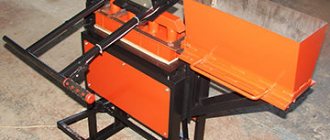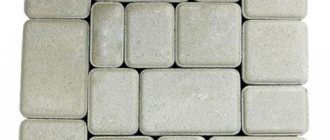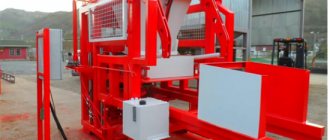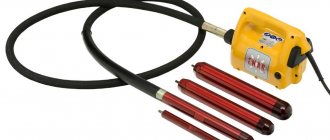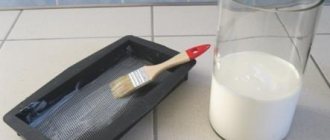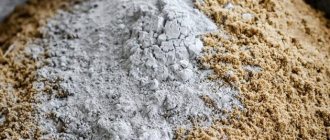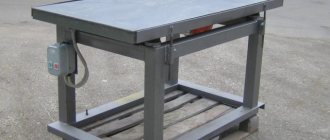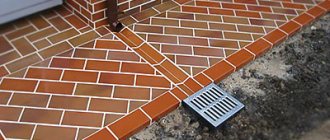How are paving slabs made?
The technology for making paving slabs is quite simple: a sand-cement mixture is poured into molds and hardens. But tiles made in this way will turn out loose and very fragile.
To obtain the desired product, a vibropress is used, in which concrete is poured into a vibrating matrix, and a press presses on top of the cement mortar. The industry produces similar machines.
They are designed for the production of tiles on an industrial scale. Factory vibrating presses are very expensive; if you are not going to use the machine for commercial purposes, then purchasing it does not make sense.
You can make this mechanism yourself.
Pros and cons of producing paving stones by vibrocompression
Paving slabs and paving stones produced by vibrocompression have a number of undeniable advantages over vibratory-cast analogues:
· Products are durable and have a long service life;
· The precise geometry of the manufactured paving slabs greatly facilitates the process of laying them;
· The slight roughness of the surface of the products allows pedestrians to feel more confident if the surface is wet or icy;
· Vibration-pressed tiles are frost-resistant due to the high degree of compaction of the concrete mixture and its low water content;
· Painted paving slabs retain their color saturation for many years.
The vibration pressing technology also has a small disadvantage: with large production volumes, the range of products is limited by the number of sets of punch dies available. And in order to start producing fundamentally new products, it is necessary to purchase additional forming equipment for a brick making press.
Components for brick making press
To create a brick making machine, you need to imagine how it works (you can see the operation of a factory machine), the principle is the same.
Main components of the machine:
- Plate;
- Tabletop;
- Press;
- Vibromechanism.
Before starting production, it is important to make drawings of the parts. You can find several options for the machine on the Internet. You should choose based on the availability of components.
There are options for simpler brick presses, and there are more complex and powerful ones. To calculate the size of the machine, you need to decide on the size of the tile and the number of matrices. There is no point in creating a device for one form.
Components of a brick making machine
Equipment for the production of paving slabs using vibrocompression requires the presence of a certain design, including certain components. It is quite easy to make a small machine yourself. The main thing in this event is to study everything scrupulously, make drawings, clearly think through the sequence of actions and follow the instructions. The main elements of the machine are:
- table with top;
- vibration mechanism;
- special device for pressing.
Each node has several components that are connected together in a certain way. Before you begin manufacturing a brick making machine, you must prepare detailed drawings of it. You can find them on the Internet or draw them yourself, adding your own ideas and design innovations.
It is recommended to take as a basis the proven assembly diagram created by the designers. When creating a vibration table at home, it is advisable to immediately find out which elements you can make yourself and which you will have to purchase ready-made. Be sure to remember that the equipment experiences significant loads during operation, which is why the frame must be made of steel, securing all its components with electric welding. This is how you can prevent the destruction of the structure due to constant vibration.
Making a table
The machine table is a metal frame with welded legs. Dimensions are selected in accordance with the expected power of the structure.
Approximate dimensions:
- 50 by 70 centimeters or 70 by 100 centimeters.
- The height of the legs of the mechanism must correspond to the height of the person who will work on it.
- To make the legs, you can use a steel angle 10 centimeters wide, a ten-centimeter pipe or a tenth channel.
- The load on the legs will be large, so they need to be reinforced with gussets (steel rectangles welded to the leg and frame).
If the machine does not change its location, it is recommended to fill the legs with concrete.
Frame making
Prepared blanks for the frame are welded using electric welding. Weld seams are cleaned using an angle grinder, then the entire workpiece is painted. It is advisable to paint in order to prevent rust: the cement-sand mixture is diluted with water.
The frame must have no in-plane displacements.
Making a countertop
This element of the press must be made with great strength because it will experience heavy loads.
- The dimensions of the table must match the tabletop.
- The frame is made from channel No. 10 or a corner 7cm by 7cm.
- The blanks are cut, trimmed and welded.
- When welding parts, it is necessary to ensure their evenness - during the welding process, metal structures can bend.
Then a rectangle is cut out of a 10 mm thick steel sheet, then placed on the prepared frame and welded. The top of the tabletop is a sheet.
Vibration casting machine
This machine is a flat metal table, firmly mounted on a metal spring suspension. Vibration is provided by an electric drive, the power of which should be directly proportional to the size of the table and, as a consequence, the number of simultaneously processed forms for the concrete mixture.
Vibrating table for vibratory casting
A small compact machine can easily fit into an ordinary garage, and in one working day it can produce about 1000 pieces of finished products, which is enough, on average, to cover a sidewalk with an area of 20 square meters.
It is not necessary to buy paving slabs; you can make it yourself. Manufacturing paving slabs is a technological process from start to finish.
Detailed instructions for laying paving slabs on sand are described here.
The recipe for making concrete paving slabs is described in detail in this topic.
Attaching the table top to the table
One way to secure a tabletop is to install it on springs. It is enough to install six springs about 12 cm long and 6 cm in diameter, which have great rigidity.
For springs, cups are cut out of the pipe. The diameters of the pipe and spring must match. The spring should sit tightly in the glass by one third of its length. The glasses are welded to the table and to the countertop, precisely marking their location points.
Electric motor for brick making machine
For the operation of a homemade concrete block press, an electric motor is required. The engine should be selected more powerful. It is recommended to use VI99/E. You can use any electric motor by connecting it with a belt to an eccentric.
Depending on the type, the engine is mounted below on a table top or on a work table. The electric motor is secured with bolts. To prevent the nuts from loosening due to vibration, engraving washers are used.
DIY vibration table for paving slabs, video
Instead of a vibrating press, you can make a vibrating table for paving slabs with your own hands.
The following is the sequence of work on a do-it-yourself vibrating table for paving slabs; the drawings must contain the specified data:
- dimensions (height, width, length) of the table. Can be taken accordingly 900*800*1600 mm;
- location of the vibrator and its overall dimensions;
- components of the product with dimensions.
When the drawing for the vibrating table for paving slabs is ready, you can prepare all the details and get to work:
- the base is the frame. It can be welded from a rectangular pipe 25*50 mm;
- the legs are welded from a rectangular pipe 50*50 mm;
- Plugs are mounted on the frame. Springs with a diameter of 50 mm and a length of 25 cm are inserted into the plugs to a depth of 5 cm;
- the working part of the vibrating table for paving slabs is made of 3 mm sheet metal, a 30*30 corner and a 25*50 mm rectangular pipe.
Since the entire machine experiences intense alternating loads, it is better to additionally strengthen all welded joints with welded gussets
The eccentric is made on the basis of a metal washer, which is mounted on the motor shaft. A threaded hole is cut on the side. Amplitude adjustment is achieved by unscrewing and screwing in the bolt. The bolt is secured to the washer with a locknut.
The engine is mounted motionless, according to one of the presented methods:
- at an angle of 45 degrees, to create vibrations in all planes;
- in the horizontal plane;
- in a vertical plane.
The bed and tabletop can be connected in various ways:
- the spring is attached by electric welding to the tabletop at one end, and the other is immersed in the plugs;
- the spring is welded to the tabletop and base, that is, a permanent connection is made.
Press manufacturing
The quality of paving slabs depends not only on vibration, but also on the amount of compression. You won’t be able to construct a hydraulic press with your own hands (you can use a jack).
It is easier to use human physical strength to compress the solution. The part (punch) is not difficult to make.
It is enough to weld the bracket with the axle to the table (short side). A lever is made from the profile, with a bushing at one end and a handle at the other. The lever should not be too long. It is attached to the punch. On the handle there is a remote control for turning on/off the electric motor.
Main characteristics
If a master is faced with the task of manufacturing a vibrating press for paving slabs, before work he must determine what characteristics the finished equipment should have.
Performance:
- it is necessary to determine how many products the machine should produce within an hour;
- tiles are flat products, so productivity can be calculated in square meters or compared by the number of pallets filled per unit of time;
- this characteristic depends on the level of automation of the unit, that is, the speed of changing pallets, removing finished products from the working area, and timely supply of solution to the matrix;
- When manufacturing for paving your own site, it is enough to assemble a manually controlled installation (a manual brick-making press for paving slabs) with a maximum loading weight of no more than 35 kg. One person can handle such a device.
Better performance can be achieved using various auxiliary mechanisms, however, this is relevant if the master wants to organize a larger production volume
Formation cycle:
- at home you can make a brick press for production with a formation cycle duration of about one minute;
- if you buy a brick press with high-tech characteristics, the indicator is 9-15 seconds.
Forming zone parameters:
- The area of a homemade vibrating table for paving slabs determines the dimensions of the pallet that is used when working with a specific press. This allows you to understand how many tiles of a given configuration can be produced per cycle;
- the larger the molding area, the more productive and versatile the unit will be - all this is reflected in the dimensions, power, and weight of the equipment;
- equipment for paving slabs is manufactured with a molding area of no more than 0.3 m².
Mold height:
- this parameter shows the height of the product that will be formed by the brick making machine, which depends on the dimensions of the working platform;
- The master needs to know not only the maximum parameters; the minimum height of the mold is also structurally limited. As a rule, 60-80 mm is sufficient.
Vibration frequency:
- when producing material without crushed stone, it is recommended to adjust the frequency to 100 Hz, which allows the smallest particles to be brought into resonance, improving the distribution of the working mixture;
- in other cases, a frequency of 50-75 Hz is sufficient, which is optimal for making paving stones with your own hands.
Compression force:
- the higher the pressure exerted by the machine, the stronger the finished product;
- the compression force of manual and hydraulic units differs hundreds of times;
- In order for the product to achieve the required strength, a mixture with a high content of cement and additives is loaded into weak units, which determines the final cost of the tile.
The optimal compaction coefficient is taken as 0.97-0.98, based on the consumption of Portland cement per 450-47 kg/m³ of solution
Vibrator power and parameters:
- for home production, it is enough to equip a homemade concrete block press with one vibrator with a power of 0.5 kW;
- you can increase power by using several vibration sources;
- a relatively small vibration amplitude is acceptable for a more mobile mixture, and a high amplitude for a rigid one;
- to regulate vibration parameters, an AC potentiometer should be installed;
- Please note that there are specific network requirements. There are single-phase devices operating from a 220 V network, some should be connected to a three-phase - 380 V;
- the vibrator must be correctly unbalanced and secured according to the diagram;
- incorrect placement of the device will affect the quality of the material.
How does a brick press work?
Before you start working on a homemade concrete block press, you need to properly prepare the cement-sand mixture.
The mixture consists of:
- Cement grade M 500;
- Crushed stone (fraction 5-10);
- Sand (fraction 2.5);
- Additives and dyes;
- Water.
To make high quality tiles, the mixture must be stiff. The tiles should have reduced moisture absorption and increased frost resistance.
You can check the prepared mixture using a truncated cone by lowering it into the solution. The mixture is considered to be of high quality if the steel cone enters the mixture 50 mm.
- Before filling with cement-sand mixture, the matrices must be lubricated with oil.
- This is done so that the cement does not adhere to the walls of the matrix.
- Then the cement mixture is distributed into molds.
- The matrix must coincide with the punch. By pressing the lever, the electric motor is briefly turned on.
- After this, the workpiece is removed from the matrix and laid out to dry.
With a strong desire, a minimum set of tools and materials, making a brick making machine yourself is a completely doable task.
Vibration pressing
The technique involves the use of a semi-dry working solution and almost complete automation of the production process. To work, you will need concrete mixers that allow you to prepare a working solution with a low liquid content, and a brick press.
A brick press is an automated device whose operating principle is:
- The semi-dry working mixture is supplied to the matrix molds from the loading hopper. The forms are placed on a vibrating table;
- the punch is lowered, pressing the solution against the matrix;
- vibration is turned on (vibrating table and punch);
- vibration is turned off, the matrix is removed from the product;
- The module is moved from the brickmaking press along a conveyor belt, and the cycle is duplicated.
A guillotine is a special device for splitting/cutting paving slabs. In practice, an ordinary grinder with diamond wheels is used instead.
To fully automate the process, a guillotine and loaders may be required. In addition, different types of equipment are used for work - a brick press can be stationary or manual.
A manual unit is optimal for producing material in small volumes . The device does not use a hydraulic drive, and pressing is carried out using an inertial load. The machine is installed on a flat surface and plugged into an outlet.
Characteristics of the resulting material:
- long-term operation;
- the modules are characterized by strict geometry and a rough surface;
- The concrete used in the batch has a low cement to water ratio. This determines the frost resistance (200-300 cycles), strength (M200/M400) of the tiles and reduces cement consumption.
The technique allows us to produce large volumes of modules, but of a limited variety. The quality of the tiles is higher than that of cast analogues , however, to obtain a fundamentally new product, you will need to purchase a new block with a matrix and reconfigure the equipment. For vibration casting, it is enough to buy a new mold.
